Bitcoin and Ethereum Come in from the Cold (Technical Analysis)
Petch_A_Ratana/iStock via Getty Images
DISCLAIMER: This notice is intended for US recipients only and is not specifically directed at or intended to be relied upon by any UK recipients. Any information or analysis in this note is not an offer to sell or solicitation of an offer to buy securities. Nothing in this note is intended to constitute investment advice, nor should it be relied upon to make investment decisions. Cestrian Capital Research, Inc., its employees, agents or affiliates, including the author of this note, or related persons, may have a position in any stock, security or financial instrument referred to in this note. Any opinions, analysis or probabilities expressed in this note are those of the author as of the note’s publication date and are subject to change without notice. Companies referred to in this note or their employees or affiliates may be clients of Cestrian Capital Research, Inc. Cestrian Capital Research, Inc. values both independence and transparency and does not believe that this constitutes a material potential conflict of interest or influences the content of its research or publications.
The greatest carpet cover of all time
In 2020 and much of 2021, crypto was easy money. Actually, there were two types of easy money. It was easy money if you traded it, and it was easy money if you got paid to promote it as something that everyone including your grandparents should trade.
And, like all facile schemes, it came to an ignominious end.
From this:
Crypto Bros Buy Property (NY Post)
For this:
Crypto Bankruptcy (The Tokenist)
The wild west days of jumping aboard whichever coin was trending that week are probably over as a reliable way to make money (don’t laugh – too many are our a reliable way to make money for a time).
All risk assets have been sold in 2022
From the peak in 2021, even the two leading crypto names have experienced a deep selloff. Think S&P-heavy 401k is hurting? Is your high-beta technology portfolio causing you pain and worry? Imagine if you had bought the crypto dream and waited for the Moon, the Lambo or something else.
Here are the S&P 500, Nasdaq-100, the BTC-USD cross, the ETH-USD cross, and the ARK Innovation ETF (ARKK) over the past 12 months, shown as a percentage drop from the high over that period.
% discount on top charts (YCharts.com)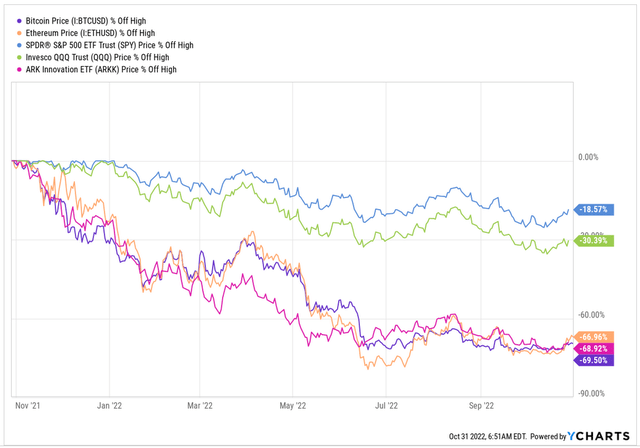
S&P painful, Nasdaq more so; crypto and ARKK together with a fall in value of 2/3. Ouch.
Of course, this has led to a certain level of fear in crypto.
Crypto Fear vs Greed Index (Alternative.me)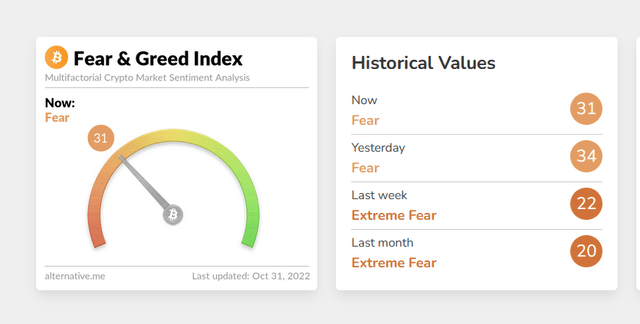
Now a theme of our work is that in securities markets it is always the opposite day. So if something is beaten up and FinTwit has decided it’s dead and buried forever, our interest is piqued.
We expect increasing strength in certain crypto assets
Crypto, we believe, is going through a split and transformation. We believe that the two leading systems – Bitcoin and Ether – will pull away from the altcoin pack. We believe that the two systems will be professionalized and institutionalized. That they will become more similar to securities both in practice and, quite likely, in principle and over time, legally. We expect all of this to annoy both the “leave the code free” math types and the “Wen Lambo” crypto bro crowd. But it will benefit institutional investors and those who choose to invest in the same way as these institutions.
In our single stock analysis we use the notion of the “Wyckoff Cycle”, which as you know is an idealized form of how large account players are able to create and realize profits solely from buying and selling activity itself, not from any underlying inherent value. We have written extensively about this elsewhere, including here.
We believe that Wyckoff-type institutional accumulation has already begun in both Bitcoin and Ether.
We track both daily against the most important stock indices – initially we did it as a sort of canary-in-the-coal-mine early indicator of risk appetite. Few instruments have as high a beta as crypto; Bitcoin and Ether are the most liquid crypto-instruments; so, we thought, we can use them as advance warning of what may come each day or week in the S&P or Nasdaq. And this is not a bad tool as it turns out. Not perfect, of course, but not bad.
However, where this became very interesting was after the June lows were hit in the stock indices. As you know, there was a violent rally to the August highs and an equally violent fall to the October lows that were under the June lows in the S&P, in the Nasdaq and the Dow, and a double test of the same lows in the case of the Russell. And crypto being high beta – meaning it overreacts to changes relative to what the S&P says – you’d expect a similar pattern plus some strengthening. Right?
Error. See. Here’s the S&P – Nasdaq and Dow follow, by the way.
SPY June vs October 2022 low (TrendSpider, Cestrian Analysis)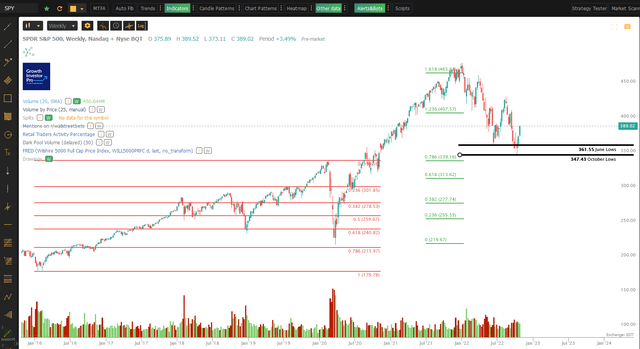
Now, look at BTC.
BTC June Lows (TradingView, Cestrian Analysis)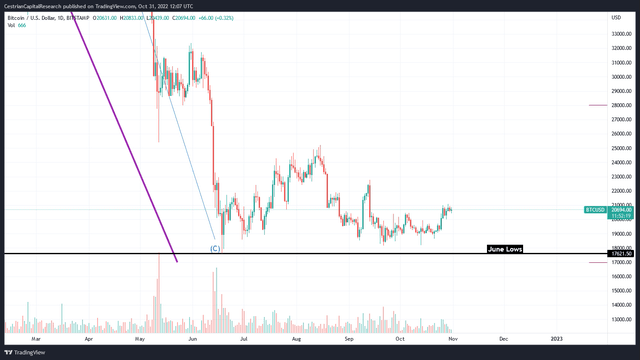
And on ETH.
June ETH Precipitation (TradingView, Cestrian Analysis)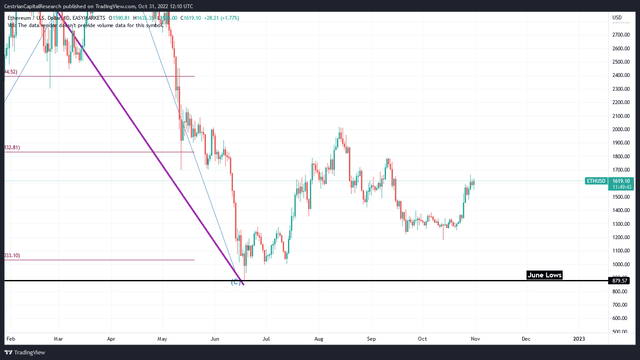
So on the face of it, this already looks interesting. Why would two very scary assets hold above their June lows when the major stock market indices did not?
Well, there are two reasons, in our view, which are not mutually exclusive.
First, derivatives. The indices and their ETFs are subject to significant pressure from the huge wall of capital that rages around the options market. In fact, if you look at large reversals of the S&P through an options market lens, you can see the power of option flows – the reversals tend to occur on large option expiration dates, after which market makers rebalance their hedges to return to a delta-neutral position. Again, here’s the S&P. (Underlying analysis includes work from SpotGamma.)
S&P – Options Expiry Impact (SpotGamma, Cestrian Analysis, TrendSpider)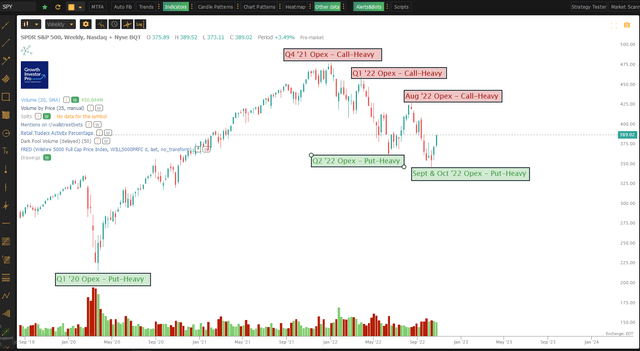
Crypto has no similar pressure from the derivatives market. So we don’t think the strength of crypto can be explained away by option expirations – however, you could make a good argument that the weakness of stock indices in September and October is due to the impact of a wall of puts being bought by investors.
No, our second reason is that we believe that Bitcoin and Ether are now being lined up by institutional investors. We believe that the price and volume activity supports this thesis.
Let’s look at Ether first, because the evidence there is more compelling than Bitcoin, in our view.
ETHUSD – volume by price analysis (TradingView, Cestrian analysis)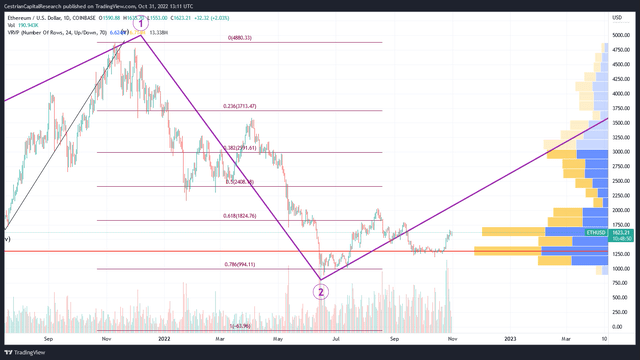
The blue/yellow bars on the right side of the chart show traded volume at each price level. The chart starts in July 2021 and the volume by price indicators does the same. The largest volumes of buying have been done in the area around $1050-$1725.
Zooming out, you can see that this price zone roughly corresponds to typical “Wave 2” (shock and awe selling!) retracement levels.
ETHUSD Fibonacci Retracement Analysis (TradingView, Cestrian Analysis)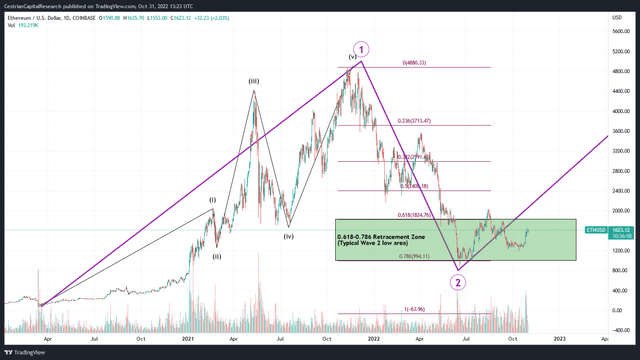
And that, in our view, is no coincidence. The reason you’re seeing shock and awe selling support around this level and the speed of the deep retracement – a Wave 2 in Elliott Wave parlance – is that this level of dumping is driving the despair you’re seeing in retail crypto right now (or e-commerce etc ., for that matter). Institutions, not inclined to despair, have long known to buy the fear, to embrace the abandonment. And this we believe is taking place in Ether right now.
If you zoom in again, you can start to see a larger scale Wave 3 (which could reach at least a new high above $4880 if we have the pattern right) taking shape with an i, ii and iii off the June lows. Like this:
ETHUSD minor wave pattern (TradingView, Cestrian analysis)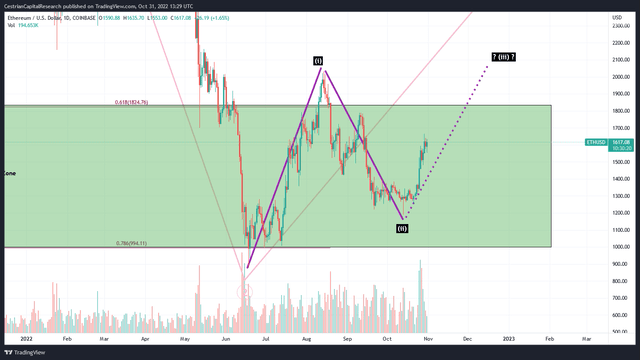
We are therefore positive about Ether. Should ETH-USD reach up and above $2,035 anytime soon, it will be further confirmation of our bull thesis.
We now turn to Bitcoin which has a less convincing chart in our opinion, but still shows signs of volume accumulation on price action, which has again hit large volumes in the same Wave 2 retracement zone down from Wave 1 from the 2020 lows into 2021 – the heights.
BTCUSD Volume x Price at 786 Retrace (TradingView, Cestrian Analysis)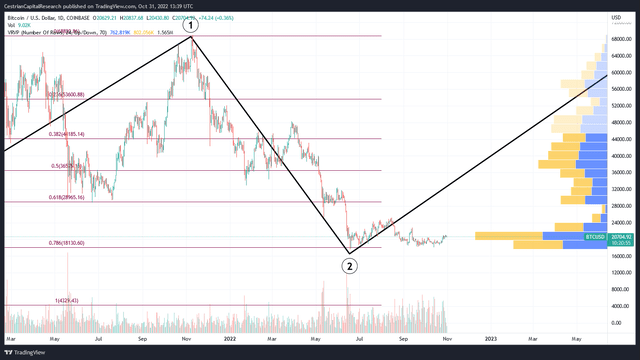
Why less compelling than Ether? Because we are yet to see the characteristic 1 up, 2 down, 3 up pattern of a new bull phase taking shape. But you can see the buildup for yourself.
We are bullish on Bitcoin – just not as bullish as we are on Ether.
Cestrian Capital Research, Inc. – October 31, 2022.


